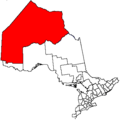Shoal Lake 34B1 | |
|---|---|
| Shoal Lake Indian Reserve No. 34B1 | |
| Coordinates: 49°26′N95°06′W / 49.433°N 95.100°W | |
| Country | |
| Province | |
| District | Kenora |
| First Nation | Animakee Wa Zhing 37 |
| Area | |
| • Land | 2.59 km2 (1.00 sq mi) |
Shoal Lake 34B1 is a First Nations reserve [1] at the southwestern end of Shoal Lake in Kenora District, Ontario. It is one of the reserves of the Animakee Wa Zhing 37 First Nation.

